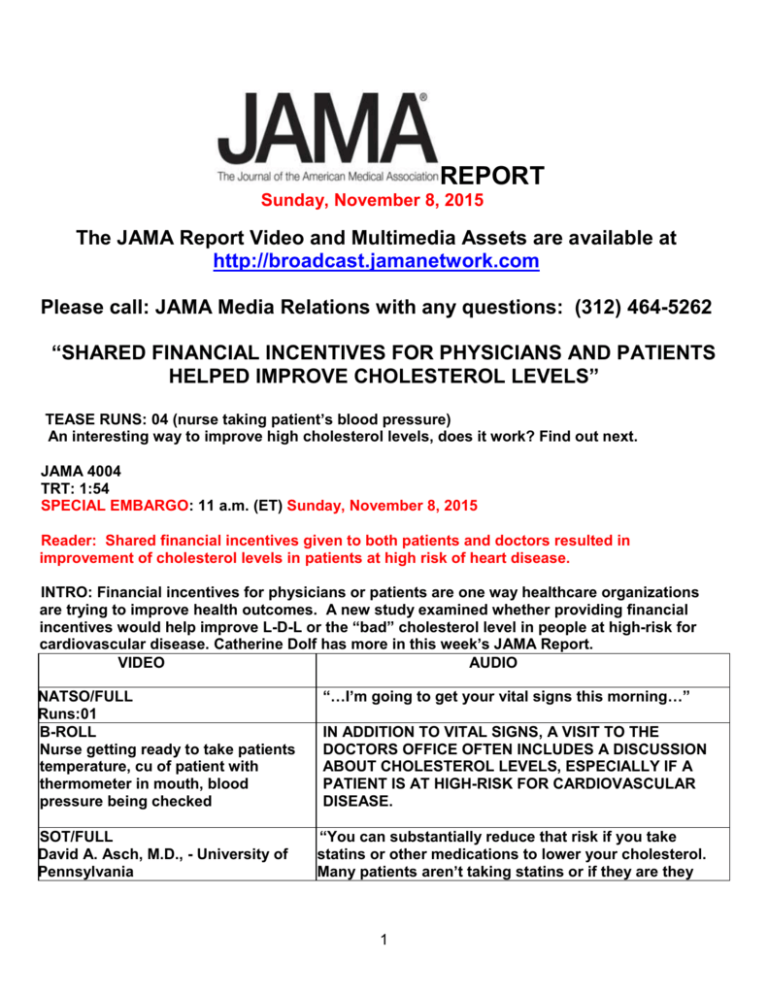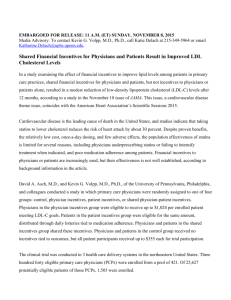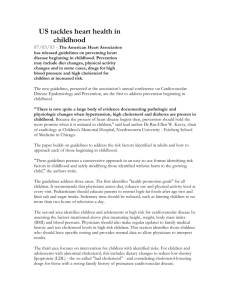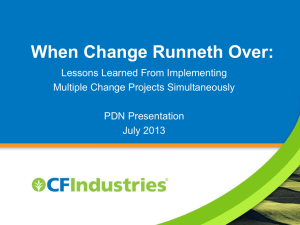video - TheNewsMarket
advertisement

REPORT Sunday, November 8, 2015 The JAMA Report Video and Multimedia Assets are available at http://broadcast.jamanetwork.com Please call: JAMA Media Relations with any questions: (312) 464-5262 “SHARED FINANCIAL INCENTIVES FOR PHYSICIANS AND PATIENTS HELPED IMPROVE CHOLESTEROL LEVELS” TEASE RUNS: 04 (nurse taking patient’s blood pressure) An interesting way to improve high cholesterol levels, does it work? Find out next. JAMA 4004 TRT: 1:54 SPECIAL EMBARGO: 11 a.m. (ET) Sunday, November 8, 2015 Reader: Shared financial incentives given to both patients and doctors resulted in improvement of cholesterol levels in patients at high risk of heart disease. INTRO: Financial incentives for physicians or patients are one way healthcare organizations are trying to improve health outcomes. A new study examined whether providing financial incentives would help improve L-D-L or the “bad” cholesterol level in people at high-risk for cardiovascular disease. Catherine Dolf has more in this week’s JAMA Report. VIDEO AUDIO NATSO/FULL Runs:01 B-ROLL Nurse getting ready to take patients temperature, cu of patient with thermometer in mouth, blood pressure being checked “…I’m going to get your vital signs this morning…” SOT/FULL David A. Asch, M.D., - University of Pennsylvania “ “You can substantially reduce that risk if you take statins or other medications to lower your cholesterol. Many patients aren’t taking statins or if they are they IN ADDITION TO VITAL SIGNS, A VISIT TO THE DOCTORS OFFICE OFTEN INCLUDES A DISCUSSION ABOUT CHOLESTEROL LEVELS, ESPECIALLY IF A PATIENT IS AT HIGH-RISK FOR CARDIOVASCULAR DISEASE. 1 Super@:10 Runs:11 (Video covering middle of bite: statin medication) SOT/FULL Kevin G. Volpp, M.D., Ph.D., University of Pennsylvania Super@:22 Runs:09 B-ROLL Dr. Volpp and Dr. Asch walking down hallway with colleague, colleague and doctors at white board, writing on white board while Dr. Asch and Dr. Volpp look on, doctor examining patient and doing different tests in exam room, patient and doctor talking SOT/FULL David A. Asch, M.D., - University of Pennsylvania Super@:53 Runs:09 SOT/FULL Kevin G. Volpp, M.D., Ph.D., University of Pennsylvania Super@ 1:03 Runs:07 (Video covering end of bite: doctor and patient talking) SOT/FULL David A. Asch, M.D., - University of Pennsylvania Super@ 1:11 Runs:03 GXF FULL JAMA LOGO SOT/FULL Kevin G. Volpp, M.D., Ph.D., University of Pennsylvania Super@ 1:21 Runs:15 stop them after a few months.” “And what we did in this study was to test a variety of strategies to try to help patients and their doctors get their cholesterol under better control.” DOCTORS KEVIN VOLPP AND DAVID ASCH FROM THE UNIVERSITY OF PENNSYLVANIA AND CO-AUTHORS STUDIED THE EFFECT OF DIFFERENT FINANCIAL INCENTIVES ON CHOLESTEROL LEVELS IN MORE THAN 15 HUNDRED PATIENTS AT HIGH RISK FOR CARDIOVASCULAR DISEASE. THE RESEARCHERS RANDOMLY ASSIGNED 340 DOCTORS TO ONE OF FOUR GROUPS. ONE GROUP DIDN’T RECEIVE ANY FINANCIAL INCENTIVES. IN ANOTHER GROUP, FINANCIAL INCENTIVES WERE GIVEN ONLY TO THE PATIENTS WHO SHOWED IMPROVEMENTS IN THEIR CHOLESTEROL. “We also tried different approaches including giving financial incentives to physicians or giving financial incentives in a shared way to both patients and physicians.” “The most effective way of improving cholesterol control was a shared incentive between patients and providers.” “They had the greatest reduction in their LDL cholesterol.” THE STUDY APPEARS IN JAMA, JOURNAL OF THE AMERICAN MEDICAL ASSOCIATION. “If patients weren’t on statins, they were started on statins. Having both the provider intensify therapy as appropriate and having the patients take those medications once prescribed, and that’s really why we think the shared incentive group was the most 2 (Video covering 1st part of bite: statin effective.” medications) SOT/FULL “We shouldn’t just think of these as mechanical David A. Asch, M.D., - University of economic transactions. Getting your cholesterol down Pennsylvania is a team effort. It requires physicians to prescribe the Super@ 1:32 medications and it requires patients to take the Runs:12 medications.” (Video covering middle of bite: patient getting blood drawn) SOT/FULL “Both of those are critically important to the end goal of Kevin G. Volpp, M.D., Ph.D., improving LDL cholesterol and reducing University of Pennsylvania cardiovascular risk.” Super@ 1:45 Runs:07 (Video covering end of bite: doctor and patient talking) B-ROLL CATHERINE DOLF, THE JAMA REPORT. Dr. and patient talking TAG: L-D-L LEVELS IMPROVED 25 POINTS IN THE GROUP RECEIVING NO FINANCIAL INCENTIVES. INCENTIVES GIVEN TO PHYSICIANS ONLY AND PATIENTS ONLY DID NOT WORK AS WELL AS WHEN INCENTIVES WERE GIVEN TO BOTH PHYSICIANS AND PATIENTS. Please see the complete study for additional information, including other authors, author contributions and affiliations, financial disclosures, funding and support, etc. TO CONTACT: Dr. David Asch and Dr. Kevin Volpp call Katie Delach at: (215) 776-6063 ADDITIONAL SOUNDBITES: David A. Asch, M.D., University of Pennsylvania QUOTE 1 Runs:15 “We were quite surprised that the physician incentives alone and the patient incentives alone didn’t get us all the way to goal. I think that reveals how complex this particular context is, in which it really takes a team effort to get to the goal posts.” QUOTE 2 Runs:09 “What we have learned is that if we create pathways and create incentives for physicians and patients, that patients can be better off long-term.” QUOTE 3 Runs:29 “The group of patients who received incentives on their own did have an increase in their adherence but it wasn’t enough to get their LDL level where we wanted it to go. Those patients for whom the physicians received financial incentives got more intensive therapy, meaning the 3 physicians prescribed statins more frequently and at a higher dose. But that wasn’t effective on its own either, getting the LDL cholesterol to where we wanted it to go.” Kevin G. Volpp, M.D., Ph.D., - University of Pennsylvania QUOTE 1 Runs:17 “In the provider intensification group, we don’t see an improvement in patient medication adherence. In the patient incentive group we don’t see an improvement in provider intensification of therapy. So it’s really this combination of the two together that really was critical to success.” QUOTE 2 Runs:23 “Incentives are being used very widely to try to improve quality of care within the U.S. However, most of those programs only incent providers and do not recognize that there are many clinical contexts where both provider behavior and patient behavior are both very essential ingredients in terms of improving patient health.” QUOTE 3 Runs:26 “Patients in our control group actually did quite well. They received wireless pill bottles. They were given participation incentives that were tied to coming in for regular visits to get their cholesterol checked every three months. And in essence, we made their actions witnessable because they knew their medication adherence was being monitored. In the control group we found an improvement in LDL cholesterol of about 25 points.” 4








